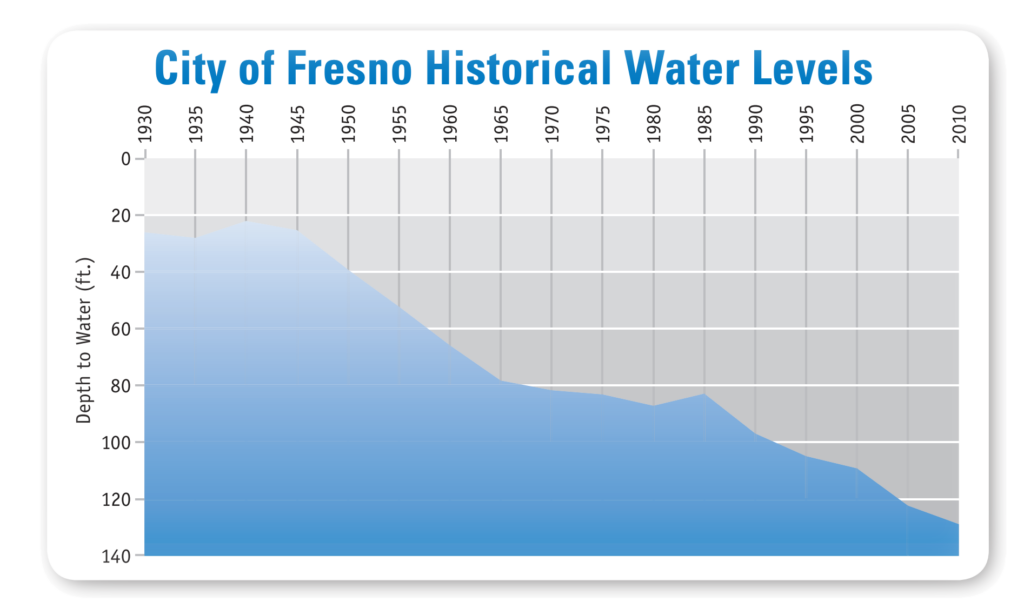Fresno Water History

The original Fresno water system began in 1876 as a nonprofit organization established by a group of public-minded citizens. Initially, the water system consisted of one pumping station, composed of small pumps and two storage tanks located above the second floor of one of an early building, located on Fresno Street between “J” and “K” Streets, presently known as Broadway and Fulton.
By the late 1880’s, the town had grown into a small city in need of an improved water distribution system, so in 1888, the first pumping station and water tower of a permanent nature were constructed at Fresno and “O” Streets. These facilities were designed to be an integral part of a larger and continually expanding water system. This first station was in continuous use until 1959, when it was retired, having served its usef ul purpose. Today, this building, which has since been declared a historical structure, is widely known throughout Fresno as the “Water Tower”.
In 1926, the plant and distribution system was purchased by the California Water Service Company. In 1931, the company sold the water system to the City of Fresno, which operated as a municipal utility. It was first managed under an appointed water board, and is currently a Division of the Public Utilities Department.
Timeline
1876
The original Fresno water system began as a nonprofit organization, inaugurated by a group of public-minded citizens.
1885
Fresno was incorporated. The City covered three square miles and had a population of 3,000 people.
1888
The first pumping station and water tower, of a permanent nature, were constructed at Fresno and “O” Streets. The owner and operator of the system was the Fresno Water Company.
1887-1890
4-inch & 2½-inch cast iron pipe, and 4-inch wrought iron water mains were laid out. Some of these original pipes are still an integral part of our present water supply system.
1894
The Fresno Water Tower was completed at the corner of Fresno and O Streets at a cost of $20,000. It was built by the Fresno Water Company.
1904
The Fresno Water Company was purchased by Balch, Kerckhoff & Wishon, and reorganized as the Fresno City Water Co.
1926
The plant and distribution system was purchased by the California Water Service Company.
1931
California Water Service Company sold the water system to the City of Fresno, which operated as a municipal utility. It was first managed under an appointed water board.
1954
The City of Fresno’s outermost city limits were Gettysburg to the North, Winery to the east, Hughes to the west and Vine Avenue to the south. There were 111,000 residents in the City.
1956
The Water Division pumped 16,384,942,000 gallons of water (50,283 ac.ft.) at a cost of $166,171.78.
1960
There were 45,879 water customers in Fresno.
1971
Leaky Acres began percolating water into the underground aquifer.
1989
Fresno County Waterworks Districts, within the City’s sphere of influence, merged with the City of Fresno. The Water Division began operating the systems.
1996
The City adopted the Fresno Metropolitan Water Resource Plan to address growth and correct historic groundwater overdraft.
2004
The City’s first Surface Water Treatment Facility located in Northeast Fresno, started delivering water June 2004.
2005
The City Council approved a resolution renewing the Central Valley Project (CVP) contract with the U. S. Bureau of Reclamation for a period of 40 years.
2006
The City Council authorized organization of a Utility Rate Commission to study increase of utility rates and formation of a municipal utility district.
2010
The City began installing residential water meters.
2016
Work began on the Recharge Fresno project which improved pipelines and facilities to capture and treat surface water and lessen our dependence on groundwater.
2018
The Southeast Surface Water Treatment Facility was completed and came online.

FRESNO’S DECLINING GROUNDWATER LEVELS
Over the last 80 years, Fresno’s water level has dropped from less than 30 feet below the surface in 1930, to more than 128 feet below the surface in 2009.